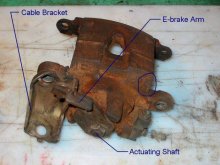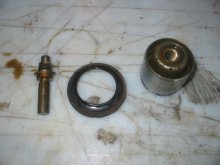|
The addition of rear disc brakes is a popular upgrade for early Broncos. Lots of creative people have accomplished this mod using components from Lincolns, Cadillacs, Ford Explorers and others. These days it's easier than ever due to the availability of commercial kits that include everything needed for the swap. Generally the kits are an adaptation of parts obtained from vehicles which came with them from the factory, most often based on a GM caliper found on 1980's vintage Cadillacs, Buicks and other GM luxury vehicles. The piston area of this caliper is a good match for the stock Ford calipers found on '76-'77 Broncos and F150s as well as the calipers used by Bronco enthusiasts for the Chevy front disc conversion. This GM caliper also incorporates an emergency brake mechanism that matches the cables found on early Broncos perfectly.
That emergency brake mechanism doesn't always work as it should, however, particularly if the calipers came from a junkyard donor vehicle. When I first did this swap, I could find no information on how the emergency brake mechanism worked, and as it turned out, mine didn't work at all for a while. I had been told that I needed to cycle the emergency brake to adjust the calipers, which I did until my foot was numb. That didn't work, so I started experimenting with the calipers, taking them apart to understand how they worked. In this article I'll explain what I learned, and how to make those bargain junkyard calipers work as expected.
DISCLAIMER: Bad brakes can kill you. If you choose to rebuild your brakes, it is your responsibility to ensure that quality parts and good shop practices are followed in every aspect of the brake system. The follow information provides guidelines on servicing Cadillac rear brake calipers only, and is not intended to be the last word on brake system design and repair. I won't be held responsible if you make a mistake. Honestly evaluate your abilities to perform brake system diagnosis, service and modifications before touching them, and hire a professional mechanic to do the job for you if you aren't certain you can do it yourself. You, your passengers and your loved ones will be better off.

First, a photo with some terminology- I need to call the components something for explanatory purposes. These are my choices for names- GM may have used something else. The picture shows a right side caliper (note the "R" on the casting) straight from the junkyard.
In a conventional disc brake caliper, the piston is advanced out of its bore as the pads wear. There is no mechanism that retracts the piston when the brakes are released, so it and the pads remain in light contact with the rotor at all times, ready to clamp when required. In the GM caliper, things are different. When the brakes are applied, the piston is forced out of its bore as always, but the parking brake mechanism inside the piston actually causes it to retract when the brakes are released. Instead, the GM caliper does indeed depend on the regular use of the emergency brake to advance the piston and remain in adjustment. When the emergency brake is applied, the lever is rotated, which causes the threaded shaft to drive the piston out of the bore and clamp the pads against the rotor. When the emergency brake is released a "one-way clutch" built into the piston slips, allowing the piston to remain extended while the clamping force is released.
The problem arises when that mechanism seizes. In the case of mine, I got them cleaned up, installed, hooked up the brake lines and bled like crazy. Tried the brakes, pedal went to the floor. A couple of pumps brought it up, but nothing I did could get a good pedal. Eventually I figured out that if I re-clocked the e-brake arm by removing it, rotating the shaft until it clamped the pads against the rotor and re-installing it angled as far back as possible, I could get my brakes to work without pumping so much. But using the e-brake still didn't make any difference. So I bought a rebuild kit from Napa (expensive at $30 per caliper) and proceeded to dismantle it. The caliper I used for the photos here was a spare, so rebuild parts aren't shown. If the caliper is in generally good condition (piston dust seal not ripped, no leaks) then a rebuild kit may not even be necessary, though some peace of mind comes from knowing that all the rubber parts in an otherwise 20 year old caliper are in good shape.

Remove the 11/16" retaining nut and wiggle the e-brake arm loose. There should be a rubber seal and a nylon washer under the arm. Remove those and set them aside (there are replacements in caliper rebuild kits). Once the arm is off, give the end of the actuating shaft a nudge and the piston will pop out, followed by a big spring. Along with a bunch of smelly old brake fluid.

Note the hex on the actuating shaft. This actually measures out to 0.55 inches, but a 9/16" wrench will turn it. The piston dust seal can be pried out carefully using a screwdriver. No need to remove the cable bracket- I've taken off a couple of them, but there is Loctite on the threads of the Torx bolt, so they are tough to get loose unless you heat the caliper bracket first in the vicinity of the bracket.

It can be seen that the actuator shaft from this caliper has a right hand thread. On a left side caliper, it's the opposite. The brass washer on the shaft is important. It's a bushing that presses against the inside of the housing to react the load of the shaft trying to force the piston out when the e-brake is engaged.
|



